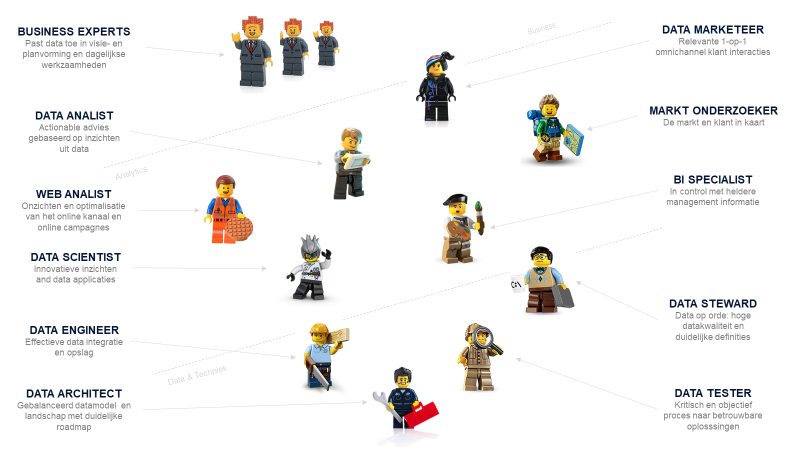In the journey toward working in a more data-driven manner, all sorts of organizational issues surface that demand answers. One important aspect we encounter a lot is how best to organize the employees working with data: the organizational structure.

Give us a ‘rake’ is then often the question we get asked.
From strategy to organization: organizational structure follows strategy….or the other way around?
Opinions on the relationship between strategy and organizational structure are rather divided if you look at the past few decades. Although we still hear the slogan “Structure follows Strategy” coming around from time to time, we must remember that this is a now 57-year-old wisdom from Harvard professor Alfred Chandler. An exclamation that certainly doesn’t hold true everywhere anymore, to say the least….
That strategy is necessary certainly also applies to the deployment of data. Big data and artificial intelligence and other terms you hear a lot in relation to data, often make people’s eyes glaze over. By creating a data strategy, you identify where you can use data and analytics to better fulfill business goals. Scoring with data. Next, you determine how you will implement the strategy. In other words, how does the vision and direction translate to the various organizational aspects, from people to resources? In which our experience shows that the organizational structure is a strong determinant for success.
An organizational structure that helps to score with data
Whereas in previous articles we have already looked in depth at data strategy and how the people side is a success factor in it, we now look specifically at the organizational structure. The organizational structure as an element which must be right in order to make the transition to data deployment successful and balanced. The use of data to the level of strategic value creation and data as the director of choices.
The ‘rake’ and pressing questions about organizational structure for data-driven work
Whenever we discuss organizational structure with clients in our consulting projects, the need arises to draw “little rakes”. Sometimes with lines, spheres or other shapes. Mainly to keep it from looking old-fashioned. After all, we don’t work in departments these days, but Agile in squads and tribes and such. But regardless of the way we choose to work as an organization, there is a need to gain clarity on:
- What kind of people do I need? What roles and competencies do you need in a data & analytics team? And how many employees per competency do you need?
- What place does it have in the organization? Where do the analysis roles fall under, do we centralize or decentralize? And how do you manage deployment and capacity and also ensure good cooperation with IT and Business departments?
- So how do I ensure engaged and inspired employees, who develop to their full potential? So how do you bundle and develop competencies optimally: where will the roles and competencies find each other, inspire and strengthen each other and how will you optimally fascinate and commit the people with these qualities?
The three-stage rocket
To answer the questions stated above, we use a three-step approach that addresses all these questions.
Step 1 is determining the required competencies and translating these into required roles/personnel, based on ambition and the current competencies present.
We bundle the competencies into roles. And in order not to make it look too complex, we visualize these roles in the form of Lego figures. A nice metaphor for building an organization. With larger organizations you get the question of how many of which kind of figures you need. In small organizations, the number of figures needed often scares people. What helps is that these are roles, where for smaller organizations it may well be that employees can fill multiple roles.
Distinguishing and naming roles and competencies helps to focus on what you need and what you already have. It thus forms the first part of the puzzle of how to set up the organization.

Step 2 is determining the possible organizational variants
In this step, we determine the most obvious organizational variants, so get to work with those rakes! What this step looks like depends on the size of the organization. So, they can vary enormously. Are you talking about a company with 50 employees and two analysts or an international player with hundreds of people in the data domain….
We explore and work out the variants. What do we do centrally and what do we do decentrally, who controls what, how do departments work together and so on. In this phase, you should restrict yourself to preferably a maximum of three variants.
Step 3 is working out the choices in a structured way…and making those choices too!
Once we have a clear picture of what we need and in what forms we can organize it, it is about making choices as objectively as possible. After all, it is about people, their job satisfaction, their attachment to the company, as well as efficiency and achieving goals. But unfortunately also about power and control and more such sensitivities.
In short, not something to be decided from the gut or on the basis of who shouts the loudest. To make the choice so transparent, we will first work out the choice criteria.
With criteria we look at objective matters such as the number of employees involved and the resolution of concrete bottlenecks. But also aspects such as: how independent analysts can bring their advice, how we can secure knowledge development up to and including the organizational variant that best facilitates achieving strategic goals.
Once there is agreement on the criteria, we then determine the weight and scores of the organizational variants. Scoring each organizational variant on a criterion ultimately creates a winner!
The powerful thing about this approach is that because of the tiered approach, you get consensus on parts of the question and not immediate discussion about the final solution. The most appropriate solution then automatically follows from the sum.
Strategy and structure are intertwined…and then you have culture as a success factor!
Whether structure follows from strategy or vice versa remains an interesting question, but don’t fall into the trap of trying to figure out a variant that fits everyone. Make choices for an organization that scores best at that moment and then dare to act, is the best motto.
When people take ownership from a clear organizational structure, things happen that mean real progress. And then it quickly becomes about culture again.




